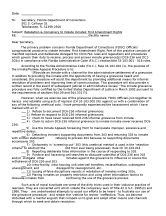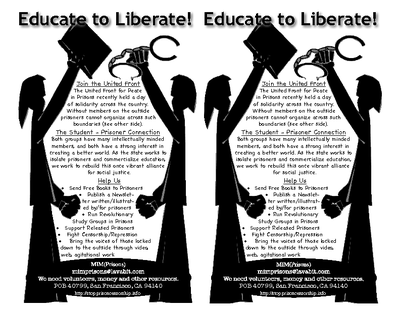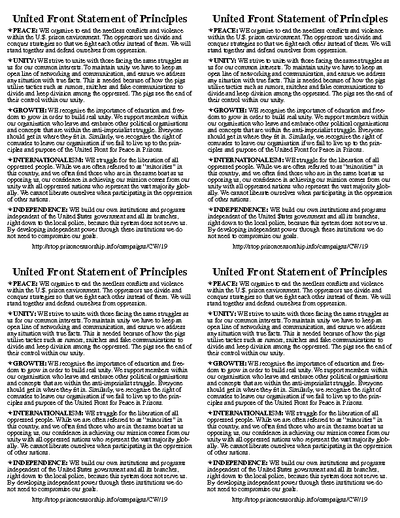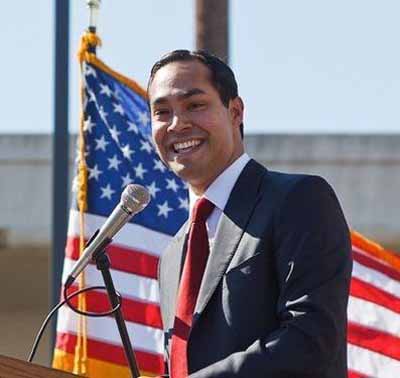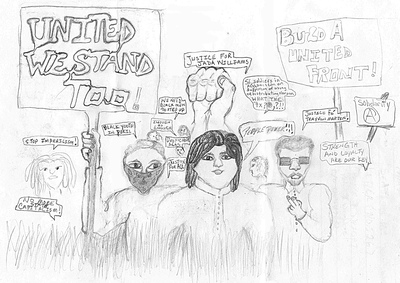
Book Review: Occupied America
Occupied America: A History of Chicanos
7th Edition
by Rodolfo F Acuña
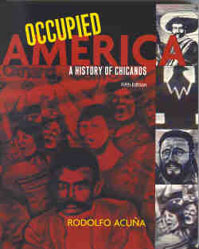
A well read book in its 7th edition, "Occupied America" is a history book for the Chican@ nation. This book has been a leading text for Chican@ studies for decades. It is an in depth analysis of Chican@ history. It is also important to note that Occupied America was one of the books banned in 2012 in Arizona and has since been a hot item for the libro trafficantes (book traffickers) who have been defying Arizona and smuggling this book back into Arizona and into the hands of Chican@ youth.
It's clear uncut content about Amerika's treatment of Chican@s along with accurate history of Chican@s rising up in resistance has Amerika scrambling to censor this work.
Occupied America was first published in 1972, emerging from a peak in national liberation struggles in the United $tates. In 1981 the second edition was released and Acuña wrote in the preface:
The first edition of Occupied America followed the current of the times, adopting the internal colonial model that was popular during the late 1960s and early 1970s. The works of Frantz Fanon greatly influenced the tone and direction of the book. Since then, just like the Chicano movement itself, I have undergone dramatic changes. I have reevaluated the internal colonial model and set it aside as a useful paradigm relevant to the nineteenth century but not to the twentieth. ...I decided to return to the basics and collect historical data.
This quote would lead us to believe that we would have more unity with the political line put forth in the first edition. Though more recent editions will have more updated information, and would likely be more valuable references for that reason. It seems that the changes between editions 2 through 7 are mostly in factual content, with an attempt to avoid polemics.
So what gets the white supremacists so disturbed about Occupied America? I chose to find out and decided to read it again.
Acuña starts the 7th edition of his book in the pre-Columbian times when civilization first started on this continent going back 50,000 years. One learns of the Aztecs, Olmecs, Zapotecs, Mayans, Incas and other natives. This naturally leads to the European invaders and the beginnings of the forging of the Mexican and then the Chican@ nation.
With the Spanish occupation and genocide that soon followed their arrival in North America, Acuña takes you through the social relations of the natives at the hands of the church.
The quest for more gold and silver and thus the mines soon led to a decimation of the native population and with this process came the resistance. But there was development as well in the economic arena. In the states that comprised "northern New Spain" at the time, like California, the Spaniards had Mestizos and natives working and so these oppressed peoples were, as Acuña explains on pg 33, the "vaqueros, soap makers, tanners, shoemakers, carpenters, blacksmiths, bakers, cooks, servants, pages, fishermen, farmers as well as a host of other occupations."
And so on the one hand the people were worked sometimes to death but on the other hand they developed economically across the region, which is a precursor to nationhood.
Acuña takes us into the Mexican revolution of 1810 when Mexico won its independence from Spain which was a great event but didn't bring socialism to Mexican@s and so the exploitation would soon return. Acuña explains the theft of Texas which was spearheaded by the white supremacist Stephen Austin starting in the 1820s. This is where the 2nd edition of the book opens up, leaving out the history above.
The myth of the Alamo is cleared up by Acuña on pg 41 where he states: "Probably the most widely circulated story was that of the last stand of the aging Davy Crocket, who fell 'fighting like a tiger' killing Mexicans with his bare hands. The truth: seven of the defenders surrendered, and Crockett was among them. The Mexican force executed them, and, one man, Louis Rose, escaped."
This book explains the myth of the oppressor nation propaganda that consumes the "history books" we read in public schools.
The U.$. war on Mexico of 1848 is explained very well and one sees the birth of the Chican@ nation in these pages. Along with this birth the layers of state propaganda are peeled back and Acuña highlights the resistance in the Chican@ nation, people like Juan "Cheno" Cantina, Francisco "Chico" Barela and Gregorio Cortez are discussed and one sees how they rose up in militias as revolutionary groups to fight yankee imperialism.
Groups like Las Gorras Blancas (the white caps) came together to defend the people with arms from white supremacy and oppression. In Occupied America we read of the early Chican@ proletariat and the militant Chican@-Mexican@ labor struggles. The 'Plan of San Diego' is discussed which was the basis of a revolutionary group that fought the U.$. government in Texas around 1915 with the goal of establishing an independent Chican@ nation, Black nation and First Nations upon victory.
We also learn of how the Treaty of Guadelupe Hidalgo was signed and Amerika stole what is now called the "Southwest." We learn that "the depression" for Amerika was normal program for Chican@-Mexican@s. Our conditions did not change and when the "New Deal" came post-depression and Amerikans were put to work on public work projects, because Chican@-Mexican@s were not allowed to participate in the "New Deal." At the time of the New Deal, the Communist International was criticizing social democracy in Europe as social fascism for appealing to the labor aristocracy interests in line with the rising fascist powers. In North America the fascist forces were not well developed, but social democracy still served to benefit the labor aristocracy to the exclusion of the oppressed nations.
The book explains the 1960s and the eruption of a new generation of Chican@s that brought the Chican@ movement on the scene. All the Chican@ groups are discussed: Masa, Mecha, Brown Berets, Black Berets, Mayo, Umas, Alianza, Crusade for Justice and many more. These fiery groups along with the many Chican@ publications that are mentioned show the times of this period and the heightened political consciousness in Aztlan.
The "teatro campesino," plays and improvised theater by and for farmworkers out in the fields, showed that Chican@-Mexican@s taking on agribusiness added to the times and Chican@ culture.
Although he provides tons of data and information on the entire history of Chican@s, the colonization process, the early development of Chican@s as a nation, and Chican@s resistance, where Acuña falls short is in this book is in failing to point out a correct path forward on how Chican@s should liberate ourselves. Oddly he only provides a short paragraph on communism and only to discuss how the state blamed communists for Chican@ activism. And so Acuña leads Chican@s to the edge of the cliff but does not tell the people how to proceed and what will liberate us.
Aztlan will only be liberated in a socialist society, when socialist revolution arrives we will finally taste freedoms. Any struggles short of this will only lead to a bourgeois revolution and a continuation of oppression, only under a new management, as happened to Mexico after the Mexican revolution.
Learning one's history is a necessary step towards liberation but once we are conscious we must then grasp how to move forward and Occupied America leaves this most important element out of the book.
Occupied America has been required reading in Chicano studies college courses in many schools across the United $tates for many decades and will continue in most schools for some time, it has a wealth of information that will continue to awaken and educate Chican@ youth and as a Chican@ historian Acuña has helped the nation in learning our history. Anyone else who wants to learn about the development of Chican@s will also enjoy this book. It is clear why the oppressor nation is so scared of this book - because it's truth!





 Alabama
Alabama
 Alaska
Alaska
 Arizona
Arizona
 Arkansas
Arkansas
 Army Post
Army Post
 California
California
 Colorado
Colorado
 Connecticut
Connecticut
 Delaware
Delaware
 District of Columbia
District of Columbia
 Federal
Federal
 Florida
Florida
 Georgia
Georgia
 Guam
Guam
 Hawaii
Hawaii
 Idaho
Idaho
 Illinois
Illinois
 Indiana
Indiana
 Iowa
Iowa
 Kansas
Kansas
 Kentucky
Kentucky
 Louisiana
Louisiana
 Maine
Maine
 Maryland
Maryland
 Massachusetts
Massachusetts
 Michigan
Michigan
 Minnesota
Minnesota
 Mississippi
Mississippi
 Missouri
Missouri
 Montana
Montana
 Nebraska
Nebraska
 Nevada
Nevada
 New Hampshire
New Hampshire
 New Jersey
New Jersey
 New Mexico
New Mexico
 New York
New York
 North Carolina
North Carolina
 North Dakota
North Dakota
 Ohio
Ohio
 Oklahoma
Oklahoma
 Oregon
Oregon
 Pennsylvania
Pennsylvania
 Puerto Rico
Puerto Rico
 Rhode Island
Rhode Island
 South Carolina
South Carolina
 South Dakota
South Dakota
 Tennessee
Tennessee
 Texas
Texas
 Utah
Utah
 Vermont
Vermont
 Virginia
Virginia
 Washington
Washington
 West Virginia
West Virginia
 Wisconsin
Wisconsin
 Wyoming
Wyoming

